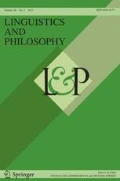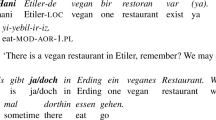Abstract
Using a version of situation semantics, this article argues that bare and complex demonstratives are interpreted as individual concepts.
Similar content being viewed by others
References
Abney, S. (1987). The English Noun Phrase in its sentential aspect. PhD Dissertation, MIT Press.
Aloni M. (2005) Individual concepts in modal predicate logic. Journal of Philosophical Logic 34: 1–64
Altshuler D. (2007) WCO, ACD and what they reveal about complex demonstratives. Natural Language Semantics 15: 265–277
Austin J.L. (1961) Truth. In: Urmson J.O., Warnock G.J. (eds) Philosophical papers. Oxford University Press, Oxford, pp 117–133
Bach E. (1970) Problominalization. Linguistic Inquiry 1: 121–122
Barwise J., Perry J. (1983) Situations and attitudes. MIT Press, Cambridge
Bäuerle R. (1983) Pragmatisch-semantische Aspekte der NP-Interpretation. In: Faust M., Harweg R., Lehfeldt W., Wienold G. (eds) Allgemeine Sprachwissenschaft, Sprachtypologie und Textlinguistik. Festschrift für Peter Hartmann. Tübingen, Gunter Narr Verlag, pp 121–131
Berman S. (1987) Situation-based semantics for adverbs of quantification. In: Blevins J., Vainikka A. (eds) Studies in semantics. Amherst, GLSA, pp 46–68
Borg E. (2000) Complex demonstratives. Philosophical Studies 97: 229–249
Braun D. (1994) Structured characters and complex demonstratives. Philosophical Studies 74: 193–219
Buchanan, R. (2002). Understanding complex demonstratives. Ms.
Buchanan R., Ostertag G. (2005) Has the problem of incompleteness rested on a mistake?. Mind 114: 889–913
Büring D. (2004) Crossover situations. Natural Language Semantics 12: 23–62
Büring D. (2005) Binding theory. Cambridge University Press, Cambridge
Carlson, G. (1977). Reference to kinds in English. PhD Dissertation, University of Massachusetts, Amherst.
Chierchia G. (1995) Dynamics of meaning: Anaphora, presupposition, and the theory of grammar. University of Chicago Press, Chicago
Chomsky N. (1981) Lectures on government and binding. Foris, Dordrecht
Chomsky N. (1993) A minimalist program for linguistic theory. In: Hale K., Keyser S.J. (eds) The view from Building 20. Essays in linguistics in honor of Sylvain Bromberger. MIT Press, Cambridge, pp 1–52
Chomsky N. (1995) The minimalist program. MIT Press, Cambridge
Cooper R. (1979) The interpretation of pronouns. In: Heny F., Schnelle H. (eds) Syntax and semantics 10: Selections from the Third Gröningen Round Table. Academic Press, New York, pp 61–92
Cresswell M. (1985) Structured meanings. MIT Press, Cambridge
Cresswell M. (1990) Entities and indices. Kluwer, Dordrecht
Edelberg W. (1994) Propositions, circumstances, objects. Journal of Philosophical Logic 23: 1–34
Elbourne P. (2001a) E-type anaphora as NP-deletion. Natural Language Semantics 9: 241–288
Elbourne, P. (2001b). On the semantics of pronouns and definite articles. In L. Bar-el & K. Megerdoomian (Eds.), WCCFL 20: Proceedings of the 20th West Coast Conference on Formal Linguistics (pp. 164–177). Somerville, MA: Cascadilla Press.
Elbourne, P. (2003). Indistinguishable participants. In P. Dekker & R. van Rooij (Eds.), Proceedings of the Fourteenth Amsterdam Colloquium (pp. 105–110). Amsterdam: ILLC/Department of Philosophy, University of Amsterdam.
Elbourne P. (2005a) On the acquisition of Principle B. Linguistic Inquiry 36: 333–365
Elbourne P. (2005b) Situations and individuals. MIT Press, Cambridge
Elbourne, P. (2008). The existence entailments of definite descriptions. Ms.
Farkas D. (1997) Evaluation indices and scope. In: Szabolcsi A. (eds) Ways of scope taking. Kluwer, Dordrecht, pp 183–215
von Fintel K. (1993) Exceptive constructions. Natural Language Semantics 1: 123–148
von Fintel, K. (1994). Restrictions on quantifier domains. PhD Dissertation, University of Massachusetts, Amherst.
von Fintel K. (2004) Would you believe it? The King of France is back! (Presuppositions and truth-value intuitions). In: Bezuidenhout A., Reimer M. (eds) Descriptions and beyond: An interdisciplinary collection of essays on definite and indefinite descriptions and other related phenomena. Oxford University Press, Oxford, pp 315–341
Fox D. (2000) Economy and semantic interpretation. MIT Press, Cambridge
Fox D. (2002) Antecedent-contained deletion and the copy theory of movement. Linguistic Inquiry 33: 63–96
Frege G. (1892) Über Sinn und Bedeutung. Zeitschrift für Philosophie und Philosophische Kritik 100: 25–50
Glanzberg M., Siegel S. (2006) Presupposition and policing in complex demonstratives. Noûs 40: 1–42
Groenendijk J., Stokhof M. (1990) Dynamic Montague Grammar. In: Kálmán L., Pólos L. (eds) Papers from the Second Symposium on Logic and Language. Budapest, Akadémiai Kiadó, pp 3–48
Grosz B., Joshi A., Weinstein S. (1995) Centering: A framework for modelling the local coherence of discourse. Computational Linguistics 21: 203–225
Harley H. (2002) WCO, ACD, and QR of DPs. Linguistic Inquiry 33: 659–664
Heim, I. (1982). The semantics of definite and indefinite noun phrases. PhD Dissertation, University of Massachusetts, Amherst.
Heim I. (1990) E-type pronouns and donkey anaphora. Linguistics and Philosophy 13: 137–177
Heim I. (1991) Artikel und Definitheit. In: Stechow A., Wunderlich D. (eds) Semantik. Ein internationales Handbuch der zeitgenössischen Forschung. Berlin, Walter de Gruyter, pp 487–535
Heim, I. (1993). Anaphora and semantic interpretation: A reinterpretation of Reinhart’s approach. University of Tübingen Seminar für Sprachwissenschaft working paper series (SfS-Report-07-93).
Heim I., Kratzer A. (1998) Semantics in generative grammar. Blackwell, Oxford
Heim, I., Kratzer, A., & von Fintel, K. (1998). Introduction to intensional semantics. Class notes, MIT.
Higginbotham, J., & May, R. (1981). Crossing, markedness, pragmatics. In Proceedings of the 1979 GLOW Conference. Pisa: Scuola Normale Superiore de Pisa.
Hindley J.R., Seldin J.P. (1986) Introduction to combinators and λ-calculus. Cambridge University Press, Cambridge
Jacobson, P. (1977). The syntax of crossing coreference sentences. PhD Dissertation, University of California, Berkeley.
Jacobson, P. (1991). Bach-Peters sentences in a variable-free semantics. In P. Dekker & M. Stokhof (Eds.), Proceedings of the Eighth Amsterdam Colloquium (pp. 283–302). Amsterdam: ILLC, University of Amsterdam.
Jacobson P. (2000) Paycheck pronouns, Bach-Peters sentences, and variable-free semantics. Natural Language Semantics 8: 77–155
Johnson K., Lepore E. (2002) Does syntax reveal semantics? A case study of complex demonstratives. Philosophical Perspectives 16: 17–41
Kadmon, N. (1987). On unique and non-unique reference and asymmetric quantification. PhD Dissertation, University of Massachusetts, Amherst.
Kaplan D. (1989a) Demonstratives. In: Almog J., Perry J., Wettstein H. (eds) Themes from Kaplan. Oxford University Press, Oxford, pp 481–563
Kaplan D. (1989b) Afterthoughts. In: Almog J., Perry J., Wettstein H. (eds) Themes from Kaplan. Oxford University Press, Oxford, pp 565–614
Karttunen L. (1971) Definite descriptions with crossing coreference. Foundations of Language 7: 157–182
Kayne R. (1984) Connectedness and binary branching. Foris, Dordrecht
Keenan E. (1972) On semantically based grammar. Linguistic Inquiry 3: 413–461
King J. (2001) Complex demonstratives. MIT Press, A quantificational account. Cambridge
Kitagawa, Y. (1986). Subjects in Japanese and English. PhD Dissertation, University of Massachusetts, Amherst.
Kratzer A. (1989) An investigation of the lumps of thought. Linguistics and Philosophy 12: 607–653
Kratzer, A. (2004). Covert quantifier restrictions in natural languages. Ms.
Kripke S. (1972) Naming and necessity. In: Davidson D., Harman G. (eds) Semantics of natural languages. Reidel, Dordrecht, pp 253–355
Kripke S. (1979) Speaker’s reference and semantic reference. In: French P.A., Uehling T., Wettstein H. (eds) Contemporary perspectives in the philosophy of language. University of Minnesota Press, Minneapolis, pp 6–27
Ladusaw, W. (1979).Polarity sensitivity as inherent scope relations. PhD Dissertation, University of Texas, Austin.
Larson R., Segal G. (1995) Knowledge of meaning. An introduction to semantic theory. MIT Press, Cambridge
Lasnik H., Stowell T. (1991) Weakest crossover. Linguistic Inquiry 22: 687–720
Lewis D. (1968) Counterpart theory and quantified modal logic. Journal of Philosophy 65: 113–126
Link G. (1983) The logical analysis of plurals and mass terms: A lattice-theoretical approach. In: Bäuerle R., Schwarze C., Stechow A. (eds) Meaning, use and interpretation of language. Walter de Gruyter, Berlin, pp 302–323
Longobardi G. (1994) Reference and proper names: A theory of N-movement in syntax and logical form. Linguistic Inquiry 25: 609–665
May, R. (1977). The grammar of quantification. PhD Dissertation, MIT Press.
May R. (1985) Logical form. Its structure and derivation. MIT Press, Cambridge
May R. (1989) Interpreting logical form. Linguistics and Philosophy 12: 387–436
Neale S. (1990) Descriptions. MIT Press, Cambridge
Neale S. (1993) Term limits. In: Tomberlin J.E. (eds) Philosophical perspectives 7: Logic and language. Atascadero, Ridgeview Publishing, pp 89–123
Neale S. (2005a) A century later. Mind 114: 809–871
Neale S. (2005b) Pragmatism and binding. In: Szabó Z.G. (eds) Semantics versus pragmatics. Clarendon Press, Oxford, pp 165–285
Neale S. (2007) Heavy hands and scene-reading traps. European Journal of Analytic Philosophy 3: 77–130
Nunberg G. (1979) The non-uniqueness of semantic solutions: Polysemy. Linguistics and Philosophy 3: 143–184
Nunberg G. (1993) Indexicality and deixis. Linguistics and Philosophy 16: 1–43
Nunberg G. (2004) Descriptive indexicals and indexical descriptions. In: Bezuidenhout A., Reimer M. (eds) Descriptions and beyond: An interdisciplinary collection of essays on definite and indefinite descriptions and other related phenomena. Oxford University Press, Oxford, pp 261–279
Partee B., Rooth M. (1983) Generalized conjunction and type ambiguity. In: Bäuerle R., Schwarze C., Stechow A. (eds) Meaning, use, and the interpretation of language. Walter de Gruyter, Berlin, pp 362–383
Percus O. (2000) Constraints on some other variables in syntax. Natural Language Semantics 8: 173–229
Postal P. (1966) On so-called ‘pronouns’ in English. In: Dinneen F. (eds) Report on the seventeenth annual round table meeting on linguistics and language studies. Georgetown University Press, Washington, DC, pp 177–206
Quine W.V.O. (1969) Ontological relativity and other essays. Columbia University Press, New York
Recanati F. (1993) Direct reference. Blackwell, From language to thought. Oxford
Recanati F. (2004) Literal meaning. Cambridge University Press, Cambridge
Recanati F. (2005) Deixis and anaphora. In: (eds) Semantics versus pragmatics. Clarendon Press, Oxford, pp 286–316
Roberts C. (2002) Demonstratives as definites. In: Deemter K., Kibble R. (eds) Information sharing: Reference and presupposition in language generation and interpretation. CSLI Press, Stanford, pp 89–136
Roberts C. (2003) Uniqueness in definite Noun Phrases. Linguistics and Philosophy 26: 287–350
Roberts C. (2004) Pronouns as definites. In: Bezuidenhout A., Reimer M. (eds) Descriptions and beyond: An interdisciplinary collection of essays on definite and indefinite descriptions and other related phenomena. Oxford University Press, Oxford, pp 503–543
Russell B. (1905) On denoting. Mind 14: 479–493
Sag, I. (1976). Deletion and logical form. PhD Dissertation, MIT Press.
Schlenker P. (2003) A plea for monsters. Linguistics and Philosophy 26: 29–120
Seligman J., Moss L. (1997) Situation theory. In: Benthem J., ter Meulen A. (eds) The handbook of logic and language. Elsevier/MIT Press, Amsterdam/Cambridge, pp 239–309
Soames S. (1987) Direct reference, propositional attitudes, and semantic content. Philosophical Topics 15: 47–87
Sperber D., Wilson D. (1986) Relevance: Communication and cognition. Blackwell, Oxford
Stanley J. (2002) Review of King 2001. The Philosophical Review 111: 605–609
Stockwell R., Schachter P., Partee B.H. (1973) The major syntactic structures of English. Holt, Rinehart and Winston, New York
Strawson P. (1950) On referring. Mind 59: 320–344
Takahashi, E., Conroy, A., Lidz, J., & Phillips, C. (2006). Early mastery of constraints on binding and coreference. Ms.
Taylor B. (1980) Truth-theory for indexical languages. In: Platts M. (eds) Reference, truth and reality. Routledge and Kegan Paul, London, pp 182–198
Thornton R., Wexler K. (1999) Principle B, VP ellipsis, and interpretation in child grammar. MIT Press, Cambridge
Uriagereka J. (1995) Aspects of the syntax of clitic placement in Western Romance. Linguistic Inquiry 26: 79–123
van Benthem J. (1995) Language in action. Categories, lambdas and dynamic logic. MIT Press, Cambridge
van Eijck J., Kamp H. (1997) Representing discourse in context. In: Benthem J., ter Meulen A. (eds) Handbook of logic and language. Elsevier/MIT Press, Amsterdam/Cambridge, pp 179–237
Wolter, L. (2006). That’s that: The semantics and pragmatics of demonstrative noun phrases. PhD Dissertation, University of California, Santa Cruz.
Author information
Authors and Affiliations
Corresponding author
Rights and permissions
About this article
Cite this article
Elbourne, P. Demonstratives as individual concepts. Linguist and Philos 31, 409–466 (2008). https://doi.org/10.1007/s10988-008-9043-0
Received:
Accepted:
Published:
Issue Date:
DOI: https://doi.org/10.1007/s10988-008-9043-0



